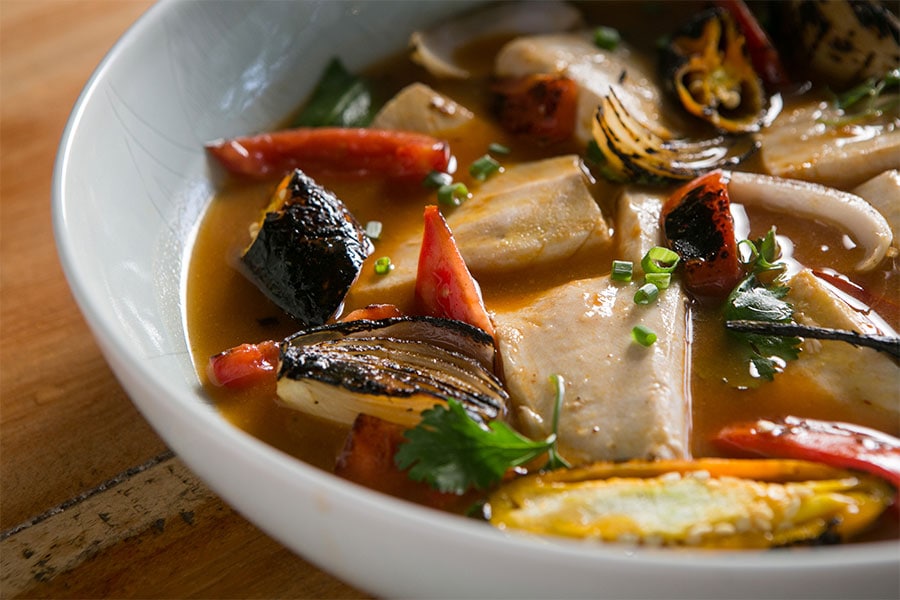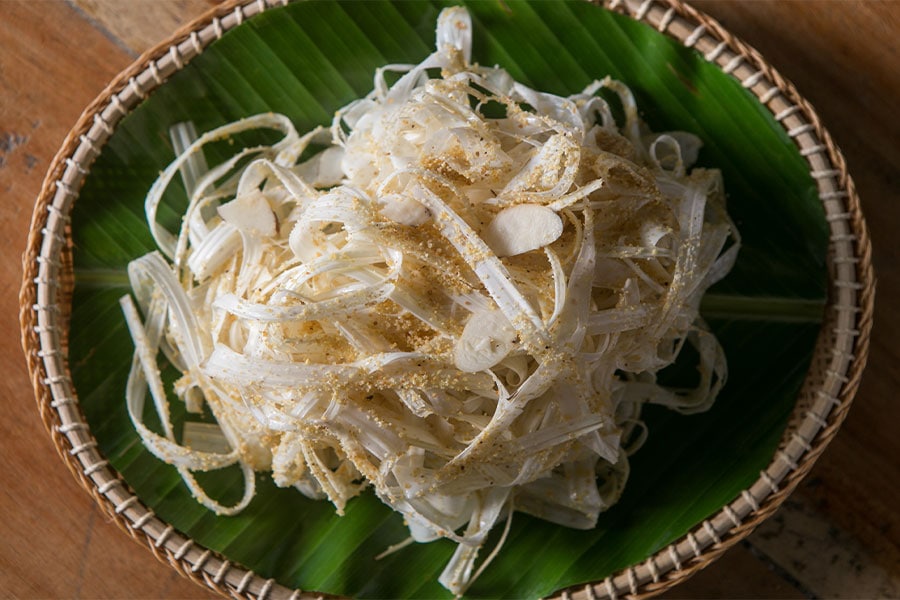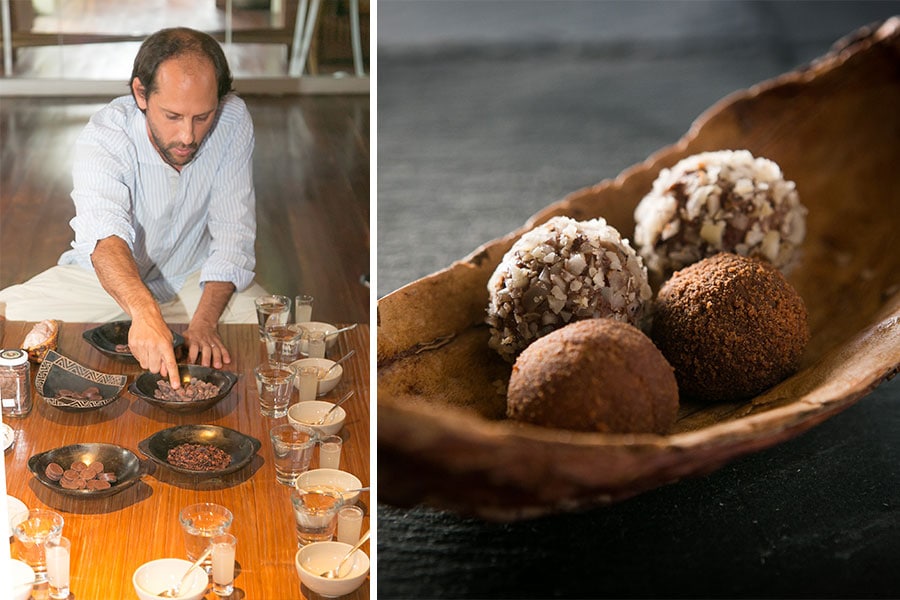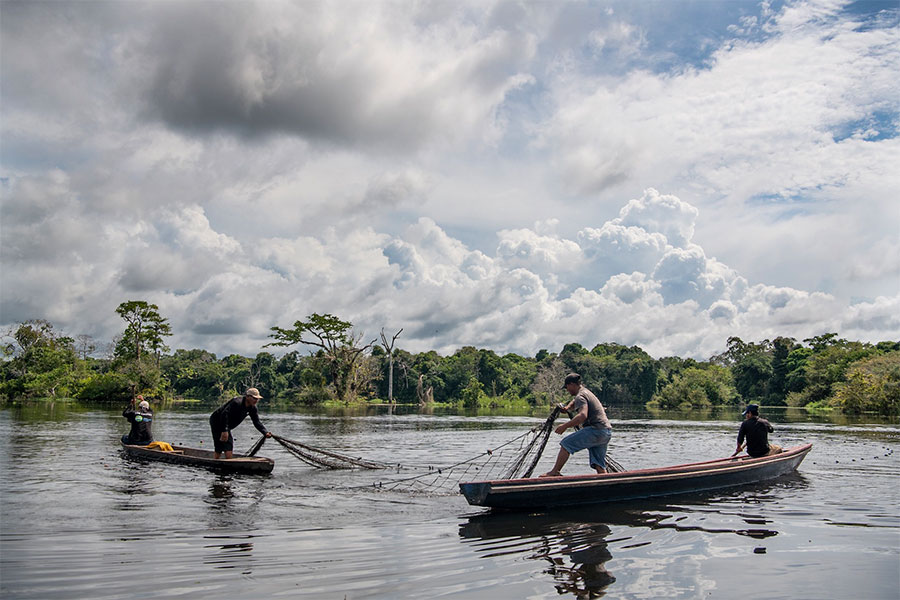
A Culinary Journey: Discover Authentic Gourmet Peruvian Food
If there is a direct way to experience the culture of another country, it is surely through its food. Mention Peruvian cuisine and quinoa is most likely to be the first thing to pop to mind. The humble mountainous pseudo-cereal has certainly come a long way to global superfood stardom since its pre-Incan roots, but there is so much more to Peruvian gastronomy than mere gluten-free hype. Join Aqua Expeditions and Amazonian cuisine proponent chef Pedro Miguel Schiaffino on a culinary journey of discovery to find out what makes Peruvian flavors unique and how their complexity completes the wonderfully wild experience of our Amazon expeditions.
The Three Elements
The distinct geography of Peru contributes to a variety of microclimates and altitudes, creating a range of resources for agriculture and unique local gastronomic offerings. The country boasts 24 different states whose diverse biodiversity are proudly represented not only in their cultural identity but also cuisine.
There are three rich regions that set the base for culinary indigenous foundations: the Andean highlands, the Pacific Coast, and the Amazon rainforest basin. Each offers spectacular and influential cultural combinations of cooking techniques and ingredients, resulting in a mouth-watering explosion of flavors that we know today.
Sky

The Moray terraces of Cusco
Food domestication and production has existed in the mountainous regions of the Andes as far back as 8,000 years, with the pre-Columbians and Incans the first to cultivate arable land into agricultural terraces and irrigation systems. They were able to hybridize and genetically diversify crops, creating and isolating thousands of subspecies of crops, including more than 3,000 types of potatoes, and other indigenous staples like the now ubiquitous quinoa, kiwicha (amaranth), corn (maize), sweet potatoes, maca, tubers such as ulluco, oca, squash and fruits. The cuisine of this region pays tribute to ancestral methods in the cooking of pachamanca (meat and vegetables baked underground with hot stones) and huatia (earthen oven), cuy chactado (deep-fried guinea pig), among other dishes.
Sea
The coastal region runs from Chile to Ecuador and is abundant in seafood fed from the ocean and many fertile rivers. Divided into two separate divisions because of their different climates and food products, the savannah desert climate of the north is famous for its region-specific staples such as fermented corn beer, loche pumpkin, sutil lemon (key ingredient for cebiche), and many varieties of chili peppers that are grown in this area. In comparison, the southern coast’s subtropical desert climate boasts river shrimps, pisco grapes, lima beans, with famous dishes being stuffed rocoto peppers and chupe de camarones (shrimp chowder).
Earth
60 percent of Peru is covered by the Amazon low and highland jungles, with half a million inhabitants including tribes such as the matsiguenga, yanesha, and shipibo-conibo. It is also home to over 2000 fish species and tropical fruit like lucuma, cherimoya, guanabana, as well as wild game, spices, peppers, nuts and other naturally grown foods such as guava, avocado, yams and yucca, making it the world’s largest pantry. The exceptional diversity of the region is reflected in the vitality of its cuisine: juane (rice tamale with meat or fish with yucca and plantains) wrapped in bijao leaves), tacacho con Cecina (roasted plantain fritters with dried pork meat), suri (an edible worm delicacy), paiche patarashca (fish wrapped in leaves), roasted macambo, and camu camu lemonade are just some region-specific specialties to try.
Foreign Fusion
With an already bountiful harvest of ingredients available, colonization by the Spanish in the 16th century further developed the nuances of flavors and palate by introducing Moorish influences such as lentils, chickpeas, livestock meats, onions, spices, figs, and honey desserts which have become inextricable from modern-day Peruvian cuisine.
With the earliest conquistadors came African slaves, who worked as soldiers and later in fields, cultivating sugarcanes, rice, and wine. The cuisine that resulted from creative experimentation of plantation kitchen leftovers is what we have come to know as antichuchos, which have become the backbone of Criollo or Creole recipes and are still sold by carretillas or street carts to this day. Eaten with tacu tacu (fried leftover rice and beans), boiled potato, corn, and aji pepper sauces, offals are seasoned with garlic, vinegar, cumin, and salt are skewered on sugarcane and grilled over an open flame.

Variety of corn that can be found in local markets
When Peru gained independence in the 1820s, there was a wave of European immigration into the country bringing along recipes and cooking methods of their homelands, in particular France and Italy. However, the true gastronomic impact on Peruvian food came from the East. With more than a million Peruvians of Chinese origin, it is only natural that Asian influences have made its way into the country’s cuisine, blending heritage, techniques and flavors. The use of rice, new frying practices, and ingredients such as soy sauce and ginger, combined with Peruvian ingredients have generated the unique chifa (a translation of ‘eat rice’ in Mandarin) experience that has captivated Peruvians and the world.
Much like the Chinese, Japanese immigrants to Peru have put their own twist on Peruvian food. This marriage of cuisines is termed Nikkei, resulting in an influential and global gastronomic movement that has changed the Peruvian culinary scene with its artistry and delicate yet complex essence. To gain insight into the taste of Japanese-Peruvian cuisine, try tiradito – thinly sliced raw fish served in an ambrosial sauce.
World’s Best
It is this power of evolution and reinvention that has resulted in Peruvian chefs leading the vanguard of some of the finest and innovative restaurants in the world. Peru itself boasts 10 restaurants on the current Latin America’s 50 Best Restaurants list, with two placing within the top ten of the current World’s 50 Best Restaurants list.

Poached catfish
This is no small feat, considering the country’s journey from gastronomic oblivion to global culinary destination of choice within the past two decades. Much of this success is thanks to the drive to rebuild a distinctive cultural identity post-internal conflict and the curiosity of a handful of upcoming chefs intent on remaking gritty Lima into the culinary capital of South America.
The undeniable revolutionary of modern Peruvian food movement is Gastón Acurio, who returned from Le Cordon Bleu in Paris in 1994 to champion his culinary heritage and spread it to the world by utilizing indigenous ingredients and multicultural flavors with a boundary-pushing sense of purpose. Having opened his first restaurant Astrid & Gastón in Lima, Acurio now boasts a Peruvian food empire with over 40 restaurants in a dozen countries, including the La Mar cevicheria which can be found in six cities from San Francisco to Buenos Aires, and Tanta, a homestyle restaurant which has spread native Peruvian flavors to as far as Chicago and Madrid.
As if that is not enough, Acurio also opened The Pachacútec Culinary Institute which gives back with its social impact on young people with limited resources. The program provides a complete education in the history of Peruvian cuisine, kitchen techniques, nutrition, and the English language. The classes are taught by the best chefs of the Acurio Corporation restaurants as well as outstanding professionals of ‘signature cuisine’. The best graduates are offered internships in the best restaurants in the world, thus bridging Peru with the world, and the old guard with the new.

Peruvian ceviche
One cannot mention Peruvian cuisine without the presence of another famous name: Nobu Matsuhita, who laid the foundations of Nikkei cuisine more than forty years ago together with another Japanese chef Toshiro Konishi. Nobu went on to share his experience of Peruvian food with the world including dishes like ceviche and tiradito, as well as ingredients such as chili peppers, rocoto peppers, and lemon in the menus of over 50 of his eponymously named restaurants.
Those that followed in these giant footsteps include Virgilio Martinez, whose flagship restaurant Central currently ranks sixth on The World’s 50 Best Restaurants 2019 and third in Latin America’s 50 Best Restaurants. Mitsuharu Tsumura’s Maido is currently Peru’s top Nikkei experience, ranking number ten in The World’s 50 Best Restaurants 2019 and voted The Best Restaurant in Latin American in both 2017 and 2018.
Rainforest-to-Table
High on the list of chefs bringing Peruvian flavors to the world is our very own consulting chef Pedro Miguel Schiaffino, who is the first Peruvian chef to specialize in Amazonian cuisine. Both his restaurants ámaZ and Malabar regularly feature on the yearly Latin America’s 50 Best Restaurants list, communicating and connecting audiences to the Amazon.
At ámaZ, every element from the music to the design tells a story about the traditions and history of the location. The plate ware is handmade by artisans in Iquitos, the tables at the main hall are contained inside an interpretation of ‘Malocas’ (ancestral houses native to indigenous communities of the Amazon), whose shape can also be seen as the traditional ‘Juane’ (the Peruvian Amazon’s most iconic dish), while the ceiling represents Shipibo tribal iconography.

Fresh heart of palm with brazilian nut oil
As a key partner in the Cumari Rainforest to Table movement, he works with scientists, environmentalists, social entrepreneurs, forest communities, journalists, and other acclaimed Latin American chefs to protect the Amazon biodiversity. This initiative has created sustainable economic opportunities for native communities by supporting responsible resource management and sustainable food businesses while working towards a cultural shift in how audiences consume and value food and its source, fostering a love and appreciation for Amazonian products.
A Natural Partnership
2007 marked the beginning of a longstanding collaboration between Pedro Miguel Schiaffino and Aqua Expeditions as he joined the team as Consulting Chef on the Aria Amazon. He oversees the entire culinary experience by creating an innovative menu focused on fresh and locally-sourced produce – 70 percent of all ingredients used onboard are sourced within the Amazonia. His ability to transform unusual ingredients into authentic delectable dishes is echoed in Aria Amazon and now the soon-to-launch Aqua Nera’s culinary offering which includes spicy river snails with tapioca and turmeric sofrito, roasted cocona salad, and coca leaf alfajores.

Cacao tasting with Pedro Miguel Schiaffino
Aqua Expeditions’ partnership with Pedro Miguel Schiaffino transcends the unique culinary proposal offered onboard our expeditions, with meaningful collaborations for conservations projects, as well as our work with local river communities to foster sustainably sourced produce in the Amazon taking centre stage.
Among the initiatives Schiaffino has spearheaded with his own nongovernmental organization, Despensa Amazonica, together with writer Andrea Ortiz de Zevallos is the Tucupí Negro project – to sustainably source a thick black sauce made from fermented, yellow liquid extracted from grated yuca root and flavored with piquant Amazonian chilis, nutty macambo seeds and leafcutter ants, helping the Pucaurquillo community and economy. Thanks to its success, the Sustainable Paiche project was born in 2017 to connect paiche fisherman of the Amazon with Lima’s top chefs, resulting in the rehabilitation of the nearly extinct species and driving up its value up nearly 500 percent.

Fishing in the amazon
Aboard Aqua Expeditions, Schiaffino showcases an expansive range of Peruvian cuisine, highlighting Amazonian ingredients at their most innovative and sophisticated. He voyages on several chef-hosted departures yearly to share his culinary knowledge with guests, revealing signature Peruvian recipes, and guiding excursions to the local fresh market to identify the day’s catch by fishermen, the region’s exotic fruits, or even sampling exotic snacks like ‘Suri’. Whether or not you are able to discover Peru’s culture and flavor by travelling the country’s diverse regions, you can be sure to experience the explosion of taste and color by sailing together with us.
Embark on a gastronomic adventure with Pedro Miguel Schiaffino onboard the Aria Amazon and Aqua Nera. Discover the amazing diversity of ingredients native to the Amazon region and experience an innovative five-star culinary menu designed to connect you to this flavorful destination.

